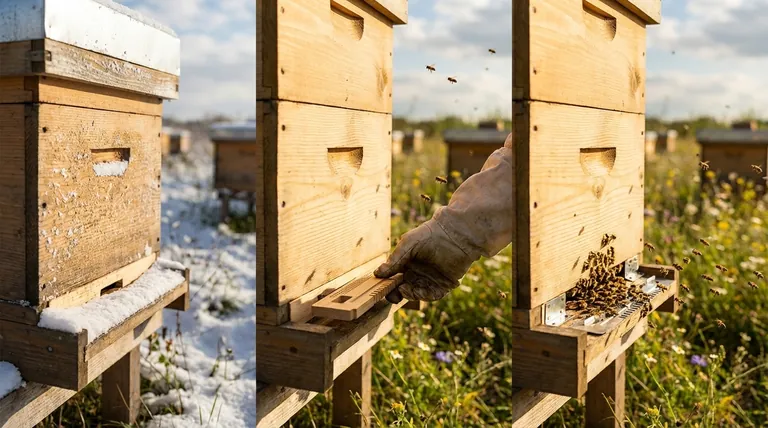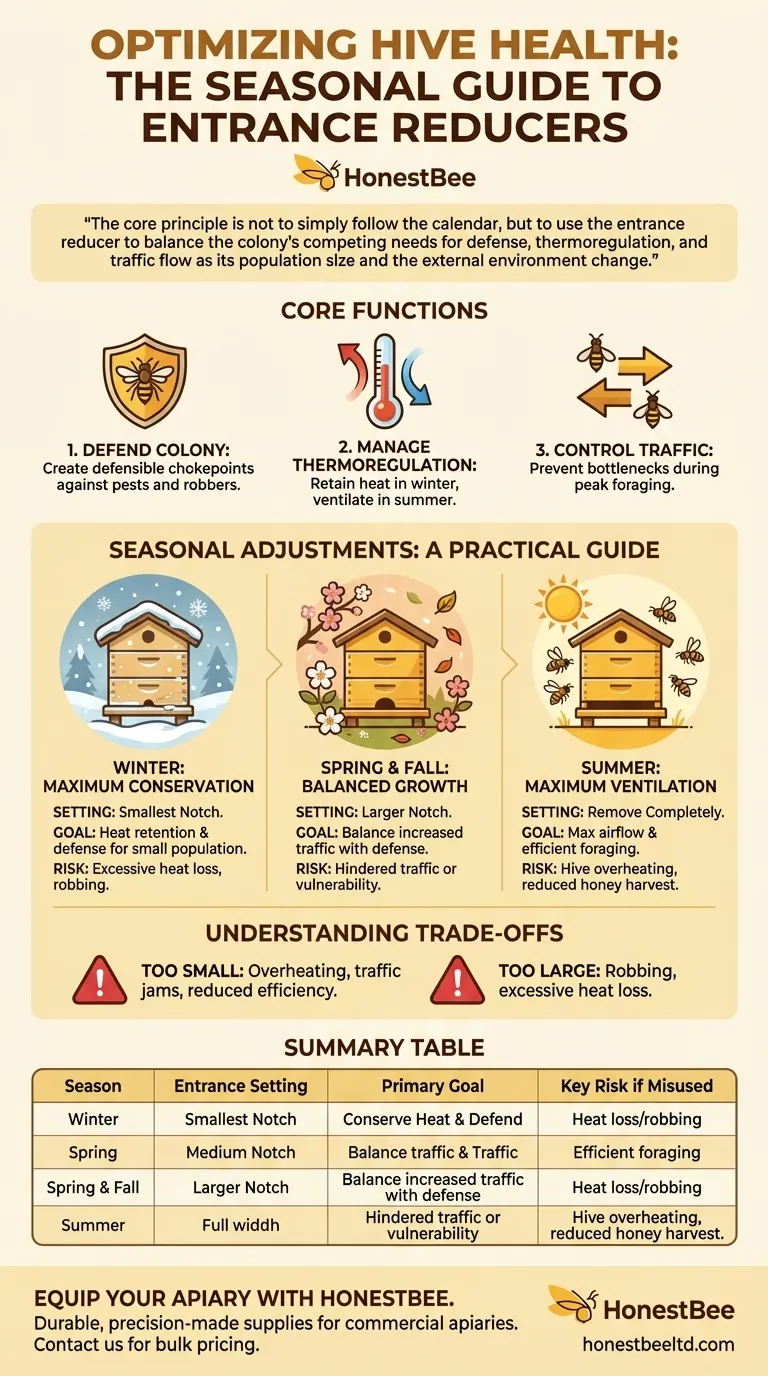An entrance reducer is your primary tool for regulating the hive's internal environment and security throughout the year. Most reducers feature two notches of different sizes, allowing you to match the entrance opening to the specific needs of the season. In winter, you use the smallest notch; in spring and fall, the larger notch; and in the peak of summer, you often remove it entirely.
The core principle is not to simply follow the calendar, but to use the entrance reducer to balance the colony's competing needs for defense, thermoregulation, and traffic flow as its population size and the external environment change.

The Core Functions of an Entrance Reducer
A simple block of wood may seem trivial, but it serves three critical functions that directly impact the health and productivity of your colony.
Defending the Colony
A smaller entrance is easier to guard. For a new, small, or overwintering colony with fewer guard bees, a large, undefended entrance is an open invitation to robbing honey bees, wasps, and other pests.
By reducing the entrance size, you create a defensible chokepoint that allows a small number of guards to effectively protect the colony's resources.
Managing Thermoregulation
Bees work constantly to maintain the hive's internal temperature. In winter, a large opening allows precious heat to escape, forcing the cluster to burn through more honey stores to stay warm.
A small winter entrance minimizes drafts and heat loss. Conversely, in hot summer weather, a wide-open entrance is essential for ventilation, allowing bees to move air and cool the hive.
Controlling Traffic Flow
During a heavy nectar flow, thousands of forager bees are entering and exiting the hive every minute. A small entrance creates a bottleneck, slowing down foraging operations and reducing the colony's overall efficiency.
Removing the reducer entirely during these peak periods prevents "bearding" at the entrance and ensures foragers can work without impediment.
Seasonal Adjustments: A Practical Guide
While you should always observe your specific colony's strength, this seasonal guide provides a reliable framework for making adjustments.
Winter: Maximum Conservation
During winter, the colony's population is at its smallest. Your primary goals are heat retention and defense against any opportunistic robbers.
Position the reducer to the smallest notch. This minimizes heat loss and provides a tiny, easily guarded entrance for the reduced population.
Spring & Fall: Balanced Growth and Defense
In spring, the queen is laying and the colony is expanding, but it is not yet at full strength. In fall, the population is decreasing in preparation for winter.
Position the reducer to the larger notch. This provides a good balance, allowing for increased traffic as the colony grows while still offering significant defensive advantages against robbers, which are common in early spring and late fall.
Summer: Maximum Ventilation and Access
During the heat of summer and the peak nectar flow, the colony is at its maximum population and strength. The primary needs are cooling and efficient foraging.
Remove the entrance reducer completely. A full-width entrance provides maximum airflow to help cool the hive and allows the massive foraging force to enter and exit without congestion.
Understanding the Trade-offs
Using the wrong entrance size at the wrong time can create significant problems for the colony. Understanding these risks is key to effective management.
The Risk of an Entrance That's Too Small
Keeping a small entrance during a strong summer nectar flow can cause traffic jams, reduce foraging efficiency, and contribute to the hive overheating. This can stress the colony and lower your potential honey harvest.
The Risk of an Entrance That's Too Large
Leaving a wide-open entrance on a weak colony, especially in the fall, is a primary cause of robbing. Stronger nearby colonies can overwhelm the weak hive and steal all of its winter stores, dooming the colony. In winter, it leads to excessive heat loss.
Making the Right Choice for Your Goal
Always let the colony's current strength and the immediate environmental conditions guide your decision.
- If your primary focus is establishing a new or weak colony: Start with the smallest opening and only expand it as the population grows and can defend a larger space.
- If your primary focus is preparing for winter: Use the smallest opening to maximize heat retention and protect diminished honey stores.
- If your primary focus is maximizing a summer honey harvest: Remove the reducer completely to ensure maximum foraging traffic and hive ventilation.
Ultimately, observing your bees' behavior at the entrance is the true key to using this simple but powerful tool effectively.
Summary Table:
| Season | Entrance Setting | Primary Goal | Key Risk if Misused |
|---|---|---|---|
| Winter | Smallest Notch | Conserve Heat & Defend Weak Colony | Excessive heat loss, robbing of stores |
| Spring/Fall | Larger Notch | Balance Growth/Decline & Defense | Hindered traffic or vulnerability |
| Summer | Reducer Removed | Maximize Ventilation & Foraging Traffic | Hive overheating, reduced honey harvest |
Equip your apiary with the right tools for every season. Proper hive management starts with reliable equipment. HONESTBEE supplies durable, precision-made entrance reducers and other essential beekeeping supplies to commercial apiaries and distributors through our wholesale-focused operations. Ensure your colonies thrive year-round—contact our team today to discuss your needs and bulk pricing.
Visual Guide

Related Products
- Beehive Entrance Reducer Guardian Metal Hive Entrance for Bees
- Multi-Functional Rotary Hive Entrance Disc for Beekeeping
- Multi-Functional Sliding Hive Entrance for Beekeeping
- Professional Reversible Beehive Hive Entrance
- HONESTBEE Wooden Bee Escape Board with Triangle Mesh Design for Beekeeping
People Also Ask
- What are the two functions of the Entrance Reducer? Master Hive Defense and Safe Transport
- How big should a beehive entrance be? Optimize for Colony Health & Honey Production
- What are the different entrance sizes for an 8 or 10-frame Langstroth hive? A Guide to Seasonal Management
- What are the features of the side with oblong holes in the entrance reducer? A Guide to Hive Defense & Health
- What are the different types of entrance reducers available? A Guide to Protecting Your Hive

















